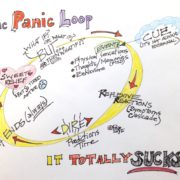Have you ever wondered why your partner triggers such an immediate response in you? Would you like to get curious not furious? Understanding your attachment style, or the way you related growing up to your primary caregiver, can provide a clue to the immediate, visceral reactions you have at times in your current relationships. Instead of getting furious, you can get curious!

Curious Not Furious
History
Consider the four attachment styles we have from John Bowlby and Mary Ainsworth’s groundbreaking work. In 1949 Bowlby wrote a report on homeless children after the war that greatly increased our understanding of the ways people react at any given time in their primary relationship. Ainsworth went on to refine our knowledge base by experimenting with babies and their different responses to caregivers and strangers.This is messy stuff, and our development over time impacts the outcomes a lot. But these basic styles have held true. The first is secure, and then there are three types of insecure attachment: anxious/clinging, anxious/avoidant, and disorganized.
The Four Attachment Styles
The good news is that over 70% of people on average have a secure style of attachment where they can sustain interdependent relationships and operate without fear of exercising their own opinions/desires, yet are able to lean on their partners for support when necessary. The other 3 styles can be problematic when trying to be relational with others.
The first insecure style is anxious/clinging, which 15% demonstrate. This means the person is unsure about the reliability of the caregiver, usually the mother. At first the baby sought soothing contact after being with the stranger in these experiments, then they rejected it. The baby was unsure about whether the mother would respond in a reassuring manner. This translates into an adult that is unsure whether or not their person will be there for them. So they always desire connection, but have a lot of fear about pursuing it, and can have a tendency towards clinging. Often there can be a trauma history that is adding to the impact of this style, or is causal.
The second insecure style, anxious/avoidant, also about 15% of the children in these experiments, demonstrated no interest in the mother. This is because the caregiver had been consistently unavailable to meet their needs, so they learn to avoid seeking the connection. This can be people who immerse themselves constantly in video games for example, or even very successful CEO’s, who have learned to place all of their efforts into other activities, and can be very high achievers while being very low in in relationship skills. One’s trauma history can be impactful here as well.
The last style is disorganized. Imagine being the child of a parent with bipolar disorder. Having to constantly adjust to different emotional signals as the person’s mood shifts from its highs and lows, can be very disorienting. It can result in an adult who responds one way this minute and a complete other five minutes later–disorganized in other words. This is a lower percentage due to the relative rarity of the circumstances.
Getting Curious, Not Furious
It is easy to see how looking at these styles of attachment can affect your relationship. They are a useful lens through which to view how you approach relationships. We don’t get to choose our attachment style in the same way we don’t get to choose our biological parents or our primary caregiver. However, increasing your awareness of your style can help you navigate your present day choices with more awareness.
Now how do you get curious? There are are a couple of good questions you might ask. Essentially it is two versions of the same question. Ask yourself “I wonder why this is so upsetting to me?” or “I wonder why this is so upsetting to my partner?” Curiosity is a much healthier approach to your relationship than fury will ever be.
If you need help with this, contact me here. Working on thorny problems in relationships takes time. My approach is to help you learn to work out your issues yourself over time by using research like that done on attachment theory to increase your awareness, and lead you to healthier, interdependent relationships that can deepen as you move through life together.











